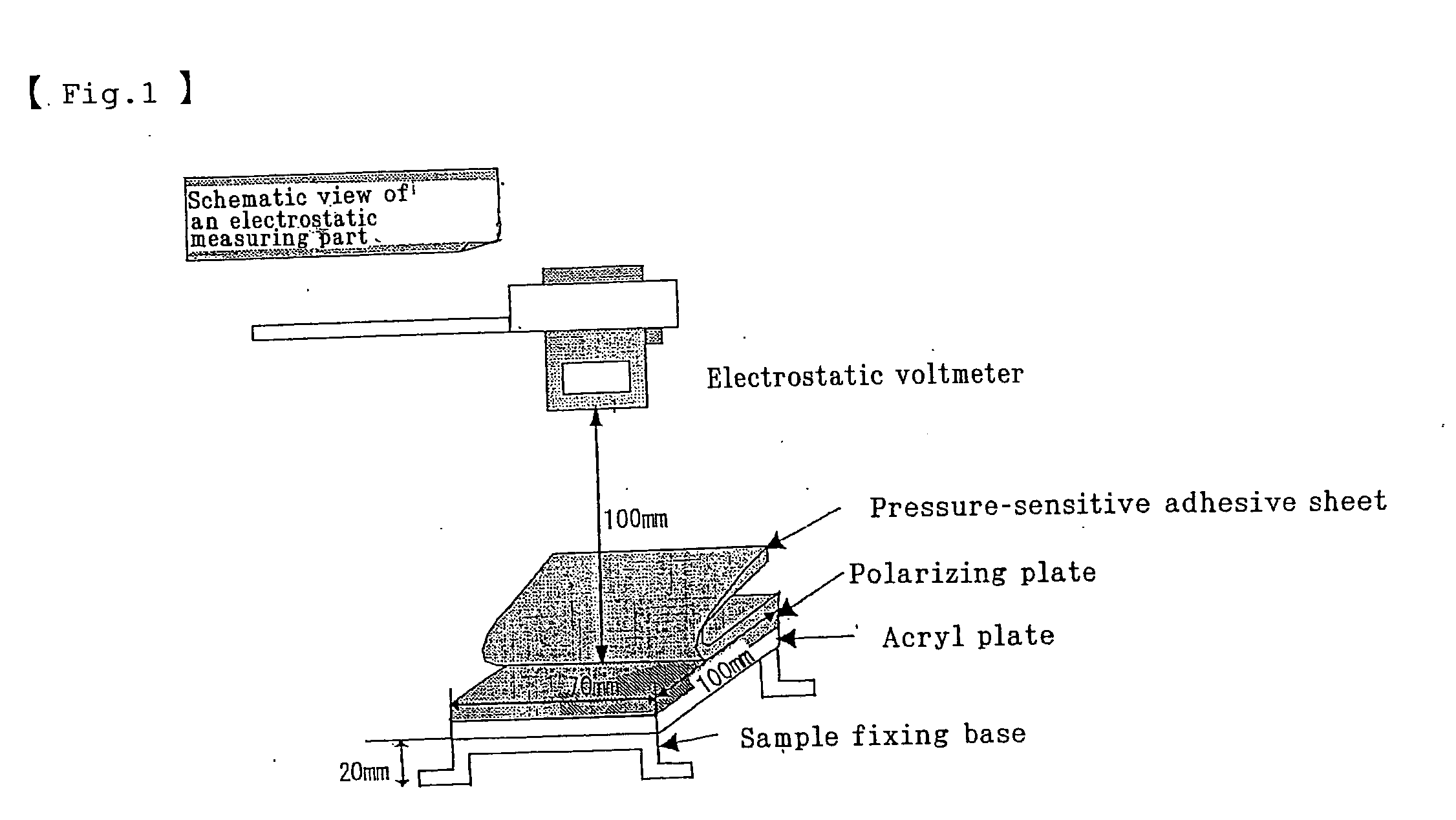Pressure-sensitive adhesive composition, pressure-sensitive adhesive sheets, and surface protecting film
a technology of pressure-sensitive adhesives and compositions, applied in the direction of film/foil adhesives, polyether adhesives, synthetic resin layered products, etc., can solve the problems of affecting the stability of the surface protection film, etc., to achieve easy control of crosslinking of pressure-sensitive adhesive compositions, reduce staining, and facilitate compatibility and well-balanced interactions
- Summary
- Abstract
- Description
- Claims
- Application Information
AI Technical Summary
Benefits of technology
Problems solved by technology
Method used
Image
Examples
examples
[0105] Examples which specifically show a construction and effect of the present invention will be explained below. Assessment items in Examples were measured as follows:
[0106] A molecular weight was measured using a GPC apparatus (HLC-8220GPC manufactured by Tosoh Corporation). Measuring conditions are as follows. [0107] Sample concentration: 0.2 wt % (THF solution) [0108] Sample injection amount: 10 μl [0109] Eluent: THF [0110] Flow rate: 0.6 ml / min [0111] Measuring temperature: 40° C. [0112] Column: [0113] Sample column; [0114] TSKguard column SuperHZ-H(1 column)+TSK gel Super HZM-H(2 columns) [0115] Reference column; [0116] TSK gel SuperH-RC(1 column) [0117] Detector: Refractive index detector (RI)
[0118] A molecular weight was obtained in terms of polystyrene.
[0119] A glass transition temperature Tg(° C.) was obtained by the following equation using the following reference values as a glass transition temperature Tgn(° C.) of a homopolymer of each monomer.
[0120] Equation:
1 / ...
example 1
[Preparation of Pressure-Sensitive Adhesive Solution]
[0151] The acryl-based polymer (A) solution (40% by weight) was diluted with ethyl acetate to 20% by weight, to 100 parts by weight of this solution were added 2.6 parts by weight of the antistatic agent solution (a) (50% by weight), 0.6 part by weight of an isocyanurate of hexamethylene isocyanate (Coronate HX manufactured by Nippon Polyurethane Industry Co., Ltd.) as a crosslinking agent, and 0.4 part by weight of dibutyltin dilaurate (1% by weight ethyl acetate solution) as a crosslinking catalyst, and mixing and stirring were performed for about 1 minute while maintaining at around 25° C. to prepare an acryl-based pressure-sensitive adhesive solution (1). In the acryl-based pressure-sensitive adhesive solution (1), a blending amount of an alkali metal salt (lithium salt) was 0.065 part by weight relative to 100 parts by weight of an acryl-based polymer.
[Preparation of Pressure-Sensitive Adhesive Sheet]
[0152] The acryl-based...
example 2
[Preparation of Pressure-Sensitive Adhesive Solution]
[0153] According to the same manner as that of Example 1 except that 100 parts by weight of a solution obtained by diluting the acryl-based pressure-sensitive adhesive solution (B) (40% by weight) with ethyl acetate to 20% by weight was used in place of 100 parts by weight of a solution obtained by diluting the acryl-based pressure-sensitive adhesive solution (A) (40% by weight) with ethyl acetate to 20% by weight, an acryl-based pressure-sensitive adhesive solution (2) was prepared. In the acryl-based pressure-sensitive adhesive solution (2), a blending amount of an alkali metal salt (lithium salt) was 0.065 part by weight relative to 100 parts by weight of an acryl-based polymer.
[Preparation of Pressure-Sensitive Adhesive Sheet]
[0154] According to the same manner as that of Example 1 except that the acryl-based pressure-sensitive adhesive solution (2) was used in place of the acryl-based pressure-sensitive adhesive solution (...
PUM
| Property | Measurement | Unit |
|---|---|---|
| Tg | aaaaa | aaaaa |
| Tg | aaaaa | aaaaa |
| Tg | aaaaa | aaaaa |
Abstract
Description
Claims
Application Information
 Login to View More
Login to View More - R&D
- Intellectual Property
- Life Sciences
- Materials
- Tech Scout
- Unparalleled Data Quality
- Higher Quality Content
- 60% Fewer Hallucinations
Browse by: Latest US Patents, China's latest patents, Technical Efficacy Thesaurus, Application Domain, Technology Topic, Popular Technical Reports.
© 2025 PatSnap. All rights reserved.Legal|Privacy policy|Modern Slavery Act Transparency Statement|Sitemap|About US| Contact US: help@patsnap.com

